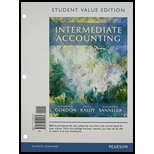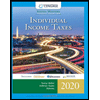
Intermediate Accounting - Myaccountinglab - Pearson Etext Access Card Student Value Edition
1st Edition
ISBN: 9780134047430
Author: Elizabeth A. Gordon, Jana S. Raedy, Alexander J. Sannella
Publisher: PEARSON
expand_more
expand_more
format_list_bulleted
Concept explainers
Textbook Question
Chapter 2, Problem 2.4E
Cash versus Accrual Bases of Accounting. Top Notch Services was founded on January 2 and offers computer consulting and other technology-related services. During its first quarter of operations, the following events occurred:
- a. In January, Top Notch provided and billed clients for $40,000 of consulting services. It was paid for these services in March.
- b. In January, Top Notch collected $25,000 from clients for services provided during the month.
- c. In February, Top Notch provided and billed clients for $45,000 of consulting services. It collected $12,000 in the current month and the remaining amount in March.
- d. In March, Top Notch collected $34,000 from clients for services provided during the month and billed clients for an additional $21,000 for services provided.
- e. Top Notch pays employees at the end of each month for service provided. Monthly payroll was $12,000, $13,000, and $15,000 in January, February, and March, respectively.
- f. Top Notch pays its utility bills at the end of each month. Utility bills totaled $800, $850, and $1,000 in January, February, and March, respectively.
- g. Top Notch hired an independent contractor who provided $1,200 of services in February. The contractor was paid in March.
Determine Top Notch’s net income for each month from January through March under both the cash and the accrual bases of accounting. Explain any difference in total net income under cash versus accrual accounting for the three months.
Expert Solution & Answer
Want to see the full answer?
Check out a sample textbook solution
Students have asked these similar questions
No AI
The accounting principle that requires matching revenues with related expenses is the:A. Going Concern PrincipleB. Matching PrincipleC. Cost PrincipleD. Full Disclosure Principle
Revenue is recognized in the accounting records when it is:A. CollectedB. EarnedC. DepositedD. Reported
The accounting principle that requires matching revenues with related expenses is the:A. Going Concern PrincipleB. Matching PrincipleC. Cost PrincipleD. Full Disclosure Principle
Chapter 2 Solutions
Intermediate Accounting - Myaccountinglab - Pearson Etext Access Card Student Value Edition
Ch. 2 - Prob. 2.1QCh. 2 - Prob. 2.2QCh. 2 - Why is a conceptual framework of accounting...Ch. 2 - Prob. 2.4QCh. 2 - Prob. 2.5QCh. 2 - Prob. 2.6QCh. 2 - Prob. 2.7QCh. 2 - When is financial information considered...Ch. 2 - Prob. 2.9QCh. 2 - Prob. 2.10Q
Ch. 2 - What is the recognition principle and when is an...Ch. 2 - What is the revenue recognition principle and when...Ch. 2 - Prob. 2.14QCh. 2 - When are expenses recognized under IFRS?Ch. 2 - How are transactions recorded under accrual...Ch. 2 - Prob. 2.17QCh. 2 - Prob. 2.1BECh. 2 - Objective of Financial Reporting. Explain the...Ch. 2 - Prob. 2.3BECh. 2 - Fundamental and Enhancing Characteristics....Ch. 2 - Prob. 2.5BECh. 2 - Prob. 2.6BECh. 2 - Prob. 2.7BECh. 2 - Fundamental and Enhancing Characteristics....Ch. 2 - Faithful Representation. Match the component of a...Ch. 2 - Prob. 2.10BECh. 2 - Prob. 2.11BECh. 2 - Capital Maintenance Adjustments, IFRS. Describe...Ch. 2 - Expense Recognition. Discuss the three main...Ch. 2 - Element Definitions. Identify whether the...Ch. 2 - Prob. 2.15BECh. 2 - Element Definitions, U.S. GAAP, IFRS. Identify...Ch. 2 - Prob. 2.17BECh. 2 - Measurement Bases. Match the measurement basis...Ch. 2 - Cash versus Accrual Bases of Accounting. The...Ch. 2 - Assumptions in Financial Reporting. Indicate the...Ch. 2 - Conceptual Framework. Noeleen Auto Mall, Ltd....Ch. 2 - Qualitative Characteristics. Referring to the...Ch. 2 - Prob. 2.3ECh. 2 - Cash versus Accrual Bases of Accounting. Top Notch...
Knowledge Booster
Learn more about
Need a deep-dive on the concept behind this application? Look no further. Learn more about this topic, accounting and related others by exploring similar questions and additional content below.Similar questions
- Which account is a contra-asset?A. Accounts PayableB. Accumulated DepreciationC. Notes ReceivableD. Prepaid Rentneedarrow_forwardIf cash is received before services are provided, what is the journal entry?A. Debit Revenue, Credit CashB. Debit Unearned Revenue, Credit CashC. Debit Cash, Credit Unearned RevenueD. Debit Accounts Receivable, Credit RevenueCorrectarrow_forwardIf cash is received before services are provided, what is the journal entry?A. Debit Revenue, Credit CashB. Debit Unearned Revenue, Credit CashC. Debit Cash, Credit Unearned RevenueD. Debit Accounts Receivable, Credit Revenuecorrectarrow_forward
- GAP Corp. is a calendar year S corporation with three shareholders. George and Anna each own 49 percent of the stock. Peter owns 2 percent of the stock. The corporation was formed on January 2, Year 1, and has been an S corporation since its inception. Using the exhibits, prepare a schedule of GAP's income, gain, loss, and deduction items for Year 2. In column B, enter the amount for federal income tax purposes. In column C, enter the amount included in GAP's Form 1120S ordinary business income (OBI) or loss. In column D, enter the amount included on GAP's Schedule K as a taxable or deductible separately stated item. Each item may have amounts entered in ordinary business income, separately stated items, or both. Enter income and gain amounts as positive numbers. Enter losses and deductions as negative numbers. If the amount is zero, enter a zero (0). A B C D 1 Income, Gain, Loss, and Deduction Items Amount for Federal Income Tax Purposes Ordinary Business Income…arrow_forwardIf cash is received before services are provided, what is the journal entry?A. Debit Revenue, Credit CashB. Debit Unearned Revenue, Credit CashC. Debit Cash, Credit Unearned RevenueD. Debit Accounts Receivable, Credit Revenue need helparrow_forwardDennis Green and Peter Olinto are equal partners in Foxy Partnership. Peter is an active general partner. Dennis is a limited partner and is not involved in the operations of the business. Foxy Partnership's Year 2 financial statements are provided in the exhibits. Using the information provided, enter the appropriate amounts to be reported on page 1 of Foxy Partnership's income tax return in the table below. Enter all amounts as positive whole values. If a response is zero, enter a zero (0). A B 1 Gross receipts or sales 2 Cost of goods sold 3 Salaries and wages 4 Guaranteed payments to partners 5 Repairs and maintenance 6 Bad debts 7 Rent 8 Depreciation 9 Other deductions 10 Ordinary business income (loss)arrow_forward
- Dennis Green and Peter Olinto are equal partners in Foxy PartneDennis Green and Peter Olinto are equal partners in Foxy Partnership. Peter is an active general partner. Dennis is a limited partner and is not involved in the operations of the business. Foxy Partnership's Year 2 financial statements are provided in the exhibits. Using the information provided, enter the appropriate amounts to be reported on page 1 of Foxy Partnership's income tax return in the table below. Enter all amounts as positive whole values. If a response is zero, enter a zero (0). 2. Cost of goods sold 3. Salaries and wages 4. Guaranteed payments to partners 5. Repairs and maintenance 6. Bad debts 7. Rent 8. Depreciation 9. Other deductions 10. Ordinary business income (loss)arrow_forwardIf a business pays off a loan, which of the following will occur?A. Assets and liabilities increaseB. Assets and liabilities decreaseC. Only liabilities increaseD. Equity decreasesarrow_forwardWhich financial statement lists revenues and expenses?A. Balance SheetB. Cash Flow StatementC. Income StatementD. Retained Earnings Statementneedarrow_forward
- No chatgpt! Which financial statement lists revenues and expenses?A. Balance SheetB. Cash Flow StatementC. Income StatementD. Retained Earnings Statementarrow_forwardWhich financial statement lists revenues and expenses?A. Balance SheetB. Cash Flow StatementC. Income StatementD. Retained Earnings StatementNo Aiarrow_forwardWhich financial statement lists revenues and expenses?A. Balance SheetB. Cash Flow StatementC. Income StatementD. Retained Earnings Statementarrow_forward
arrow_back_ios
SEE MORE QUESTIONS
arrow_forward_ios
Recommended textbooks for you
 Individual Income TaxesAccountingISBN:9780357109731Author:HoffmanPublisher:CENGAGE LEARNING - CONSIGNMENT
Individual Income TaxesAccountingISBN:9780357109731Author:HoffmanPublisher:CENGAGE LEARNING - CONSIGNMENT Auditing: A Risk Based-Approach (MindTap Course L...AccountingISBN:9781337619455Author:Karla M Johnstone, Audrey A. Gramling, Larry E. RittenbergPublisher:Cengage Learning
Auditing: A Risk Based-Approach (MindTap Course L...AccountingISBN:9781337619455Author:Karla M Johnstone, Audrey A. Gramling, Larry E. RittenbergPublisher:Cengage Learning

Individual Income Taxes
Accounting
ISBN:9780357109731
Author:Hoffman
Publisher:CENGAGE LEARNING - CONSIGNMENT



Auditing: A Risk Based-Approach (MindTap Course L...
Accounting
ISBN:9781337619455
Author:Karla M Johnstone, Audrey A. Gramling, Larry E. Rittenberg
Publisher:Cengage Learning
The ACCOUNTING EQUATION For BEGINNERS; Author: Accounting Stuff;https://www.youtube.com/watch?v=56xscQ4viWE;License: Standard Youtube License